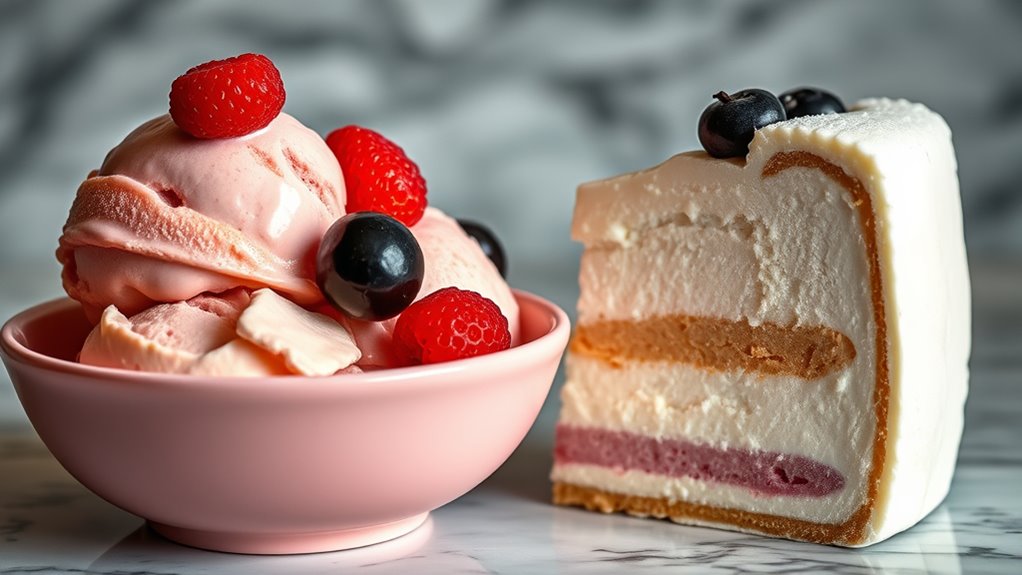On dessert menus, gelato appears as a dense, smooth, and creamy treat with a rich flavor, thanks to its churning process and high-quality ingredients. Semifreddo, however, offers an airy, mousse-like texture that can be easily prepared in molds and served in larger portions. While gelato emphasizes natural flavors with less fat, semifreddo balances richness with a lighter feel. If you want to discover more about these delicious differences, keep exploring.
Key Takeaways
- Gelato is dense, smooth, and churned for a creamy texture, while semifreddo is lighter, mousse-like, and made without churning.
- Gelato uses more milk and less cream, emphasizing natural flavors; semifreddo includes eggs and whipped cream for richness.
- Gelato is served slightly warmer for softness, whereas semifreddo is frozen in molds for a delicate, airy presentation.
- Gelato offers intense flavor with lower fat content; semifreddo balances richness with a light, fluffy texture.
- Gelato’s appearance is dense and scoopable, while semifreddo appears airy and is often served in molded slices.

When choosing between semifreddo and gelato, it helps to understand their differences in texture, ingredients, and preparation. One of the most noticeable distinctions is their texture differences. Gelato is known for its dense, smooth, and creamy consistency, which results from churning at a slower speed. This process incorporates less air, giving it a richer mouthfeel. Semifreddo, on the other hand, has a lighter, mousse-like texture. It’s typically softer than traditional ice cream but firmer than a typical mousse, achieved by folding whipped cream or egg whites into the base mixture. This difference in texture is fundamental when deciding which dessert suits your preference or the menu’s context.
Gelato is dense and creamy, while semifreddo has a lighter, mousse-like texture.
Ingredient variations also play a vital role in differentiating these two desserts. Gelato’s ingredients are simple: high-quality milk, sugar, and flavorings like fruit, nuts, or chocolate. It relies heavily on the natural flavors of these ingredients, often using more milk and less cream compared to ice cream. Its lower fat content enhances the intensity of the flavors, giving each bite a vibrant taste. Semifreddo, however, incorporates eggs and whipped cream as key ingredients, which contribute to its airy yet rich consistency. It often includes sugar, flavorings, and sometimes alcohol or fruit compote, depending on the recipe. The eggs provide structure and a velvety smoothness, while the whipped cream adds lightness, resulting in a dessert that balances richness with a delicate texture.
Preparation methods further differentiate the two. Gelato is churned in a frozen machine, which continuously stirs the mixture to prevent ice crystals from forming, ensuring a smooth, uniform texture. It’s typically served at a slightly warmer temperature than ice cream, which enhances its soft, scoopable consistency. Semifreddo, however, is made by combining ingredients and then freezing without churning. It is often prepared in a mold and then frozen until set, making it easier to produce in larger quantities or in advance. Its softer, airy texture is achieved through careful folding of whipped ingredients, which creates a dessert that’s rich yet surprisingly light.
Understanding the role of contrast ratio in the visual appeal of desserts can also influence presentation, just as it does in home cinema projectors, where contrast improves image quality. In short, understanding the texture differences and ingredient variations helps you appreciate what sets semifreddo apart from gelato. Whether you prefer the dense creaminess of gelato or the airy elegance of semifreddo, knowing these distinctions guarantees you choose the right dessert for any occasion.
Frequently Asked Questions
Can Semifreddo and Gelato Be Made Vegan?
Yes, you can make semifreddo and gelato vegan by using plant-based options. For vegan substitutions, swap dairy with coconut milk, almond milk, or cashew cream, and replace eggs with aquafaba or silken tofu. These ingredients mimic the creamy texture and richness of traditional versions. With these plant-based options, you’ll enjoy delicious vegan semifreddo and gelato that suit your dietary preferences without sacrificing flavor or texture.
Which Dessert Has Fewer Calories, Semifreddo or Gelato?
You’ll find that gelato generally has fewer calories than semifreddo, making it a lighter choice if you’re watching your dessert calorie count. On average, gelato contains about 140-200 calories per serving, while semifreddo can pack around 200-300 calories. So, if you’re aiming for a lower-calorie dessert, gelato is your better option, as it typically has less fat and sugar, helping you indulge without overdoing it.
How Long Does Semifreddo Typically Last in the Freezer?
You can store semifreddo in the freezer for about 2 to 3 weeks, making it reasonably stable if kept properly. To guarantee ideal freezer stability, wrap it tightly with plastic wrap or store it in an airtight container to prevent freezer burn and absorb odors. Remember, the longer it stays, the more its texture might change, so enjoy it within that 2-3 week window for the best taste and consistency.
Are Semifreddo and Gelato Suitable for People With Lactose Intolerance?
If you’re lactose intolerant, semifreddo and gelato might not suit you unless you look for lactose-free options or dairy alternatives. Many recipes now incorporate almond milk, coconut milk, or soy-based products, making these desserts accessible to those with dairy sensitivities. Always check ingredient lists or ask about dairy-free versions to guarantee you enjoy these treats without discomfort. Dairy alternatives let you indulge without sacrificing flavor or texture.
What Are the Best Toppings for Semifreddo and Gelato?
You’ll love adding fresh fruit toppings for a burst of sweetness and vibrant flavor, and nut garnishes for crunch and richness. Both semifreddo and gelato shine with berries, sliced bananas, or citrus zest, while chopped almonds, pistachios, or hazelnuts provide delightful texture. Combining fruit and nuts creates a perfect balance of sweetness and crunch, elevating your dessert experience and making each spoonful irresistibly delicious.
Conclusion
Now that you know the difference between semifreddo and gelato, you can confidently choose your perfect dessert. Think of semifreddo as a creamy cloud, light and airy, while gelato is like a dense, velvety treasure. Whether you prefer the airy fluff or the rich, smooth experience, both offer unique delights. So next time you’re craving something sweet, pick the one that matches your mood—your taste buds will thank you!









